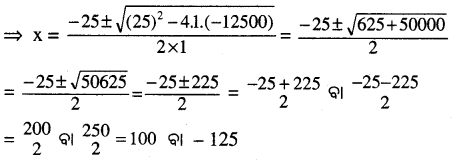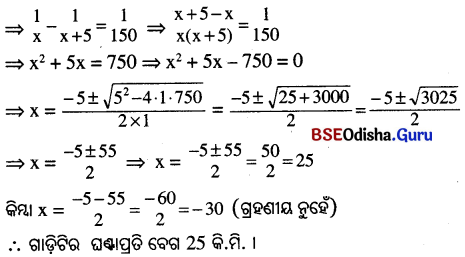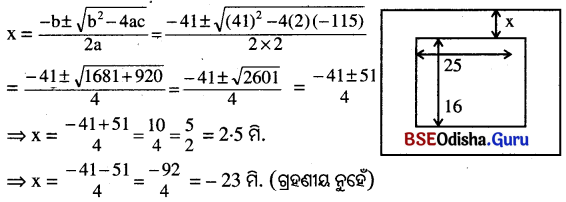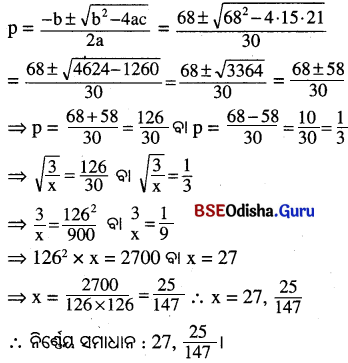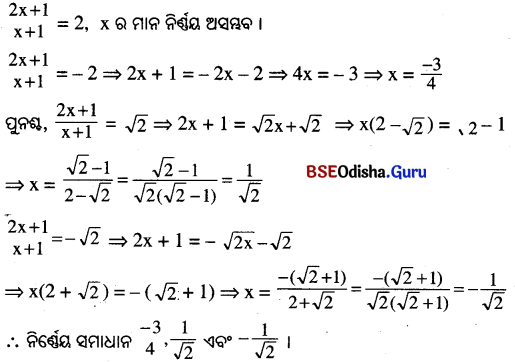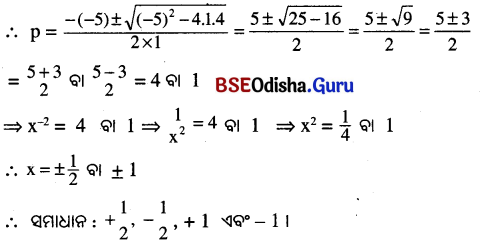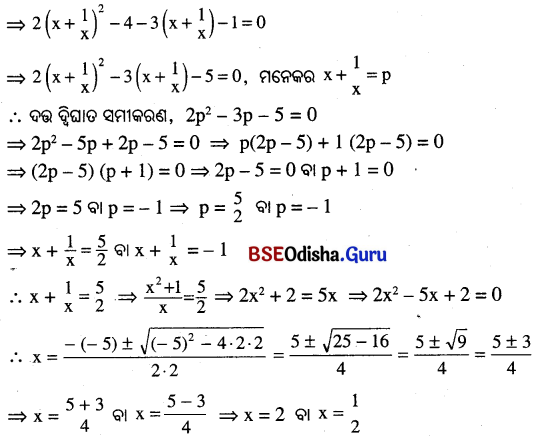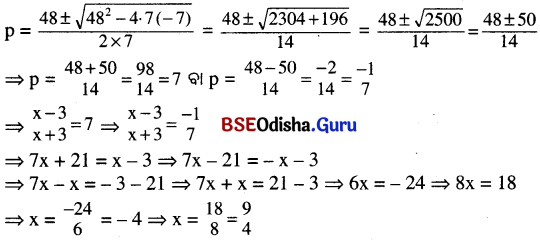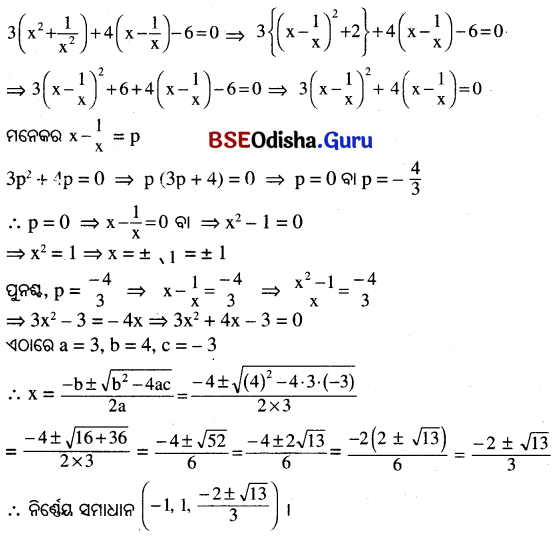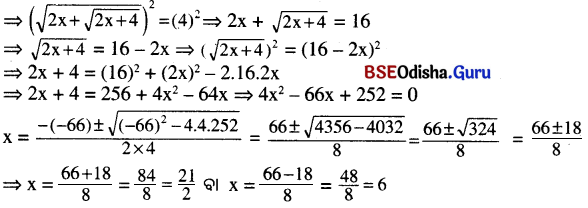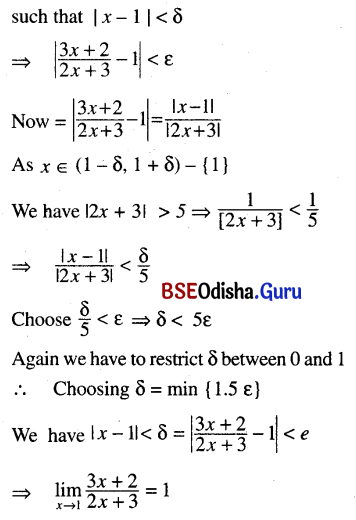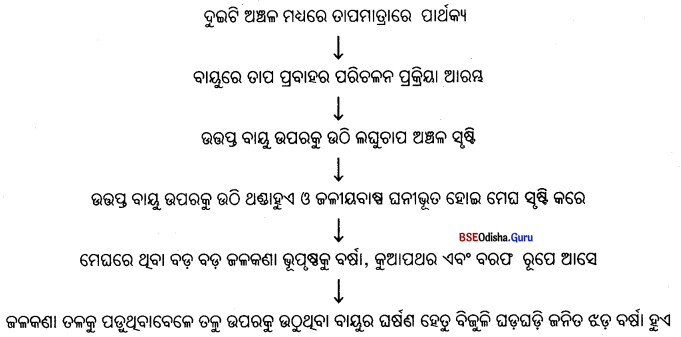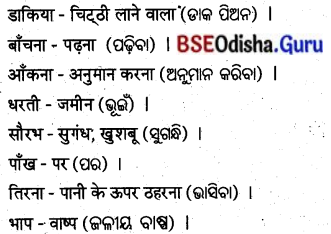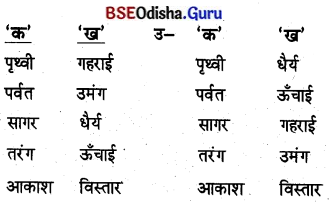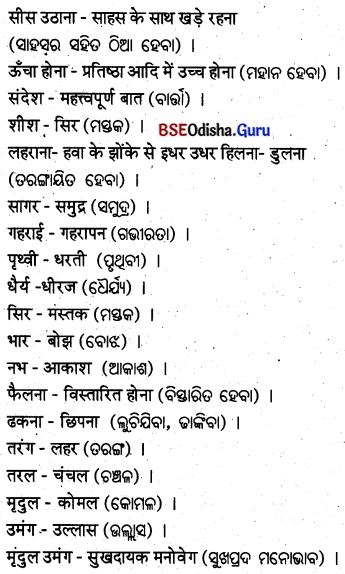Odisha State Board BSE Odisha 7th Class Geography Important Questions Chapter 1.3 ପୃଥିବୀର ଅଭ୍ୟନ୍ତର Important Questions and Answers.
BE Odisha Class 7 Geography Important Questions Chapter 1.3 ପୃଥିବୀର ଅଭ୍ୟନ୍ତର
Subjective Type Questions With Answers
ଦୀର୍ଘ ଉତ୍ତରମୂଳକ ପ୍ରଶ୍ନୋତ୍ତର
Question 1.
ଆମେ ଦେଖୁଥିବା ସ୍ଥଳ ଓ ଜଳଭାଗର ବଣ୍ଟନ କିପରି ସମ୍ଭବ ହୋଇଛି ବର୍ଣ୍ଣନା କର ।
Answer:
- ଆମେ ଦେଖୁଥିବା ସ୍ଥଳ ଓ ଜଳରାଗର ବଣ୍ଟନ ମହାଦେଶୀୟ ସଞ୍ଚଳନର ଫଳ ।
- ଭୂବିଜ୍ଞାନୀଙ୍କ ମତରେ ନିୟୁତ ନିୟୁତ ବର୍ଷପୂର୍ବେ ସବୁ ମହାଦେଶ ମିଶି ପାଞ୍ଜିଆ ଓ ସବୁ ମହାସାଗର ମିଶି ପାନ୍ଥାଲାସା ନାମରେ ପରିଚିତ ଥିଲା । ପରେ ପାଞ୍ଜିଆର ମଧ୍ୟଭାଗରେ ଟେଣ୍ଟ୍ସ୍ ସାଗର ସୃଷ୍ଟି ହେଲା । ଏହାର ଉତ୍ତର ଭାଗକୁ ଆଙ୍ଗାରାଲାଣ୍ଡ ଓ ଦକ୍ଷିଣ ଭାଗକୁ ଗଣ୍ଡୱାନାଲାଣ୍ଡ କୁହାଯାଉଥିଲା ।
- ଆଙ୍ଗାରାଲାଣ୍ଡରେ ବର୍ତ୍ତମାନର ଉତ୍ତର ଆମେରିକା, ଇଉରୋପ ଓ ଏସିଆ ମହାଦେଶ ଅନ୍ତର୍ଗତ ଥିବାବେଳେ ଗଣ୍ଡାନାଲାଣ୍ଡରେ ଆଫ୍ରିକା, ଦକ୍ଷିଣ ଆମେରିକା, ଆଣ୍ଟାର୍କଟିକା, ଅଷ୍ଟ୍ରେଲିଆ ଓ ଦକ୍ଷିଣ ଭାରତ ମାଳଭୂମି ଅନ୍ତର୍ଗତ ଥିଲା ।
- ପାଞ୍ଜିଆର ଭୂଭାଗରେ ଫାଟ ସୃଷ୍ଟି ହେବା ଦ୍ଵାରା ଉତ୍ତର ଆମେରିକା ଆଙ୍ଗାରାଲାଣ୍ଡରୁ ଓ ଦକ୍ଷିଣ ଆମେରି କା ଗଣ୍ଡୱାନାଲାଣ୍ଡରୁ ବିଚ୍ଛିନ୍ନ ହେଲା ଓ ଆଟ୍ଲାଣ୍ଟିକ ମହାସାଗର ସୃଷ୍ଟି ହେଲା ।
- ସେହିପରି ଆଫ୍ରିକାରୁ ଆଣ୍ଟାର୍କଟିକା, ଅଷ୍ଟ୍ରେଲିଆ ଓ ଭାରତର ଦକ୍ଷିଣାଶ ବିଚ୍ଛିନ୍ନ ହେବାଦ୍ଵାରା ଭାରତ ମହାସାଗରର ଉଦ୍ଭବ ହେଲା । ଏହିପରି ମହାଦେଶୀୟ ସଞ୍ଚଳନ ଫଳରେ ବର୍ତ୍ତମାନର ଜଳ ଓ ସ୍ଥଳଭାଗର ବଣ୍ଟନ ସମ୍ଭବ ହୋଇପାରିଛି ।
Question 2.
ନଦୀର କାର୍ଯ୍ୟ ଉଲ୍ଲେଖ କର ।
Answer:
- ନଦୀ ପାର୍ବତ୍ୟ ଶଯ୍ୟାରେ ଗତି କରିବା ସମୟରେ ଏହାର ବେଗ ଅତି ପ୍ରଖର ଥାଏ ଏବଂ ଏହା ତା’ର ଶଯ୍ୟାକୁ ଖୋଳି ପକାଇବା ଫଳରେ ଇଂରାଜୀ ଅକ୍ଷର ‘V” ସଦୃଶ ଉପତ୍ୟକା ସୃଷ୍ଟି ହୋଇଥାଏ ।
- ବେଳେବେଳେ ନଦୀ ବହୁ ଉଚ୍ଚରୁ କଠିନ ଶିଳା ଉପରକୁ ସିଧାସଳଖ ଲମ୍ଫ ପ୍ରଦାନ କରିଥାଏ । ଏହାକୁ ଜଳପ୍ରପାତ କୁହାଯାଏ ।
- ସମତଳ ଶଯ୍ୟାରେ ପ୍ରବେଶ କଲାପରେ ନଦୀର ବେଗ କମିଯାଏ । ଏହା ଉପରମୁଣ୍ଡରୁ ବୋହି ଆଣିଥିବା ବାଲି, ଗୋଡ଼ି, ପଥର ଆଦିକୁ ପାହାଡ଼ ତଳେ ହାତ ପଙ୍ଖା ଆକାରରେ ଜମା କରେ । ଏହାକୁ ‘ପଟୁବ୍ୟଜନ’ କୁହାଯାଏ ।
- ସମତଳ ଶଯ୍ୟାରେ ନଦୀ ସାମାନ୍ୟ ବାଧା ପାଇଲେ ଅଙ୍କାବଙ୍କା ପଥରେ ପ୍ରବାହିତ ହୁଏ । ନଦୀର ଏହି ଅଙ୍କାବଙ୍କା ଗତିପଥକୁ ନଦୀବାଙ୍କ କୁହାଯାଏ ।
- ବନ୍ୟା ସମୟରେ ନଦୀ ବୁଲାଣି ପଥ ପରିତ୍ୟାଗ କରି ସିଧାସଳଖ ପ୍ରବାହିତ ହେବା ଫଳରେ ନଦୀବାଙ୍କଟି କ୍ଷୁଦ୍ର ଅଗଭୀର ହ୍ରଦ ଆକାରରେ ରହିଯାଏ, ଯାହାକୁ ଅଶୁଖୁରାକୃତି ହ୍ରଦ କୁହାଯାଏ ।
- ବନ୍ୟା ସମୟରେ ନଦୀର ଜଳ ଏହାର ପାର୍ଶ୍ଵବର୍ତ୍ତୀ ଅଞ୍ଚଳକୁ ପ୍ଲାବିତ କରି ସେଠାରେ ବାଲି, ପଟୁ କମ୍ବାଗତ ଭାବରେ ଜମା କରିବା ଫଳରେ ଯେଉଁ ସମତଳଭୂମି ସୃଷ୍ଟି ହୁଏ, ତାହାକୁ ପ୍ଳାବନ ଭୂମି କୁହାଯାଏ ।
- ଉପକୂଳ ଅଞ୍ଚଳରେ ନଦୀର ସ୍ରୋତ ଅତି ଧୀର ହେବା ଫଳରେ ଏହା ଅନେକଗୁଡ଼ିଏ ଶାଖା ପ୍ରଶାଖାର ବିଭକ୍ତ ହୋଇଥାଏ । ଏହିଠାରୁ ନଦୀ ମୁହାଣ ପର୍ଯ୍ୟନ୍ତ ଏକ ତ୍ରିକୋଣାକାର ବିସ୍ତୃତ ସମତଳଭୂମି ଗଠିତ ହୁଏ, ଯାହାକୁ ତ୍ରିକୋଣଭୂମି କୁହାଯାଏ ।
Question 3.
ହିମବାହର କାର୍ଯ୍ୟଗୁଡ଼ିକ କ’ଣ ବର୍ଣ୍ଣନା କର ।
Answer:
- ଅତି ଶୀତଳ ଜଳବାୟୁ ଅଞ୍ଚଳ ତଥା ଉଚ୍ଚ ପର୍ବତ ଶୃଙ୍ଗଗୁଡ଼ିକରେ ତୁଷାରକଣିକାଗୁଡ଼ିକ ବରଫ ଆକାରରେ ଜମା ହୋଇ ବରଫ ଖଣ୍ଡରେ ପରିଣତ ହୋଇ ଧୀରେ ଧୀରେ ଗତି କରିବାକୁ ଲାଗେ । ଏ ପ୍ରକାର ଗତିଶୀଳ ବରଫସ୍ରୋତକୁ ହିମବାହ କୁହାଯାଏ ।
- ହିମବାହ ନିଜ ଗତିପଥରେ ସମାନ’ ପୃଷ୍ଠତଳ ଓ ତୀଖ ପାର୍ଶ୍ୱବିଶିଷ୍ଟ ଉପତ୍ୟକା ସୃଷ୍ଟିକରେ । ଏହାକୁ ଇଂରାଜୀ ଅକ୍ଷର ‘U” ସଦୃଶ ହୋଇଥିବାରୁ ଏହାକୁ ‘U’ ଉପତ୍ୟକା କୁହାଯାଏ ।
- ବେଳେବେଳେ ପର୍ବତ ଢାଲୁରେ ହିମବାହଦ୍ବାରା ସୃଷ୍ଟି ହେଉଥିବା ଆରାମଚୌକି ଭଳି ଭୂମିରୂପକୁ ସର୍କ କୁହାଯାଏ ।
- ହିମବାହ ବୋହି ଆଣୁଥୁବା ଭିନ୍ନ ଭିନ୍ନ ଆକୃତିର ଶିଳାଖଣ୍ଡ ଏହାର ପାର୍ଶ୍ଵ ତଥା ଅଗ୍ରଭାଗରେ ଜମା ହୋଇ ସୃଷ୍ଟ ସ ଭୂମିରୂପକୁ ଗ୍ରାବ କୁହାଯାଏ ।
- ଏଗୁଡ଼ିକ ହିମବାହର ପାର୍ଶ୍ବରେ ରେଖା ସଦୃଶ ଲମ୍ବି ରହିଥିବାରୁ ଏଗୁଡ଼ିକୁ ଗ୍ରାବରେଖା କୁହାଯାଏ ।
![]()
Question 4.
ଭୂତଳ ଜଳର କାର୍ଯ୍ୟଗୁଡ଼ିକ ଲେଖ ।
Answer:
- ଚୂନପଥର ଅଞ୍ଚଳରେ ଭୂତଳ ଜଳ ମୁଖ୍ୟ କ୍ଷୟକାରୀ ଶକ୍ତିରୂପେ, କାର୍ଯ୍ୟ କରେ । ଭୂମି ଉପରୁ ନିମ୍ନକୁ ପାଣି ଶୋଷି ହୋଇଯାଇଥିବା ସ୍ଥାନରେ କାହାଳୀ ସଦୃଶ ଗାତ ସୃଷ୍ଟି ହୁଏ । ଏହାକୁ ଡୋଲାଇନ୍ କୁହାଯାଏ ।
- ଡୋଲାଇନ୍ ଆକାରରେ ବଡ଼ ହେଲେ ତାକୁ ଭରାଲା କୁହାଯାଏ ।
- ଚୂନପଥର ଅଞ୍ଚଳର ଭୂମିତଳେ ବେଳେବେଳେ ବଡ଼ ବଡ଼ ଗହ୍ଵର ସୃଷ୍ଟି ହୁଏ । ଏହାକୁ ଚୂନପଥର ଗୁମ୍ଫା କୁହାଯାଏ ।
- ଚୂନପଥର ଅଞ୍ଚଳର ନଦୀ ସୁଡ଼ଙ୍ଗ ପଥ ଦେଇ ଭୂନିମ୍ନରେ ପ୍ରବାହିତ ହେଲେ ରୂପୃଷ୍ଠସ୍ଥ ନଦୀଶଯ୍ୟା ଶୁଷ୍କ ରହେ । ଏହି ଉପତ୍ୟକାକୁ ଅଦୃଶ୍ୟ ଉପତ୍ୟକା କୁହାଯାଏ ।
- ବଡ଼ ବଡ଼ ଚୂନପଥର ଗୁମ୍ଫାର ଛାତରୁ ଚୂନମିଶ୍ରିତ ଜଳଟୋପା ବିନ୍ଦୁ ବିନ୍ଦୁ ହୋଇ ତଳକୁ ପଡ଼େ ଏବଂ ଚୂନ ଅଂଶ ଭୂମିରେ ଜମା ହୋଇ ହୁଙ୍କା ପରି ଚୂନସ୍ତମ୍ଭ ସୃଷ୍ଟି ହୁଏ । ଏହାକୁ ଷ୍ଟାଲାଗମାଇଟ୍ କୁହାଯାଏ ।
- ଚୂନମିଶ୍ରିତ ଜଳ ଗୁମ୍ଫା ଛାତରୁ ଖସିବା ସମୟର କିଛି ଚୂନ ଅଂଶ ଛାତରେ ଜମିବାକୁ ଲାଗେ । କ୍ରମେ ଏହା ବଡ଼ ହୋଇ ଛାତରୁ ଓହଳ ସଦୃଶ ଝୁଲିରହେ । ଏହାକୁ ଷ୍ଟାଲାକ୍ଟାଇଟ୍ କୁହାଯାଏ ।
ସଂକ୍ଷିପ୍ତ ଉତ୍ତରମୂଳକ ପ୍ରଶ୍ନୋତ୍ତର
Question 1.
ମହାଦେଶୀୟ ସଞ୍ଚଳନ କ’ଣ ?
Answer:
- ମହାଦେଶୀୟ ସଞ୍ଚଳନ ଏକ ଅତି ଧୀର ତଥା ନିରବଚ୍ଛିନ୍ନ ପ୍ରକ୍ରିୟା ।
- ଭୂବିଜ୍ଞାନୀମାନଙ୍କ ମତରେ, ଅଶ୍ମମଣ୍ଡଳ କେତେଗୁଡ଼ିଏ ବିଶାଳ ପ୍ଲେଟ ବା ପଟଳରେ ବିଭକ୍ତ ।
- ଏଗୁଡ଼ିକ ବର୍ଷକୁ ପ୍ରାୟ ପାଞ୍ଚ ସେଣ୍ଟିମିଟର ବା ତା’ଠାରୁ କମ୍ ବେଗରେ ଗତି କରିଥାନ୍ତି । କାରଣ ଏଗୁଡ଼ିକ ଗତିଶୀଳ ମାତ୍ମା ବା ଅତରଳ ଶିଳା ଉପରେ ଅବସ୍ଥିତ ଥିବାରୁ ଏହି ପଟଳଗୁଡ଼ିକର ଗତି ସମ୍ଭବ ହୋଇଛି ।
- ଫଳରେ ଜଳଭାଗ ଓ ସ୍ଥଳଭାଗ ଅନବରତ ସ୍ଥାନ ପରିବର୍ତ୍ତନ କରିବାରେ ଲାଗିଛନ୍ତି ।
Question 2.
ପ୍ଲେଟ୍ ବା ପଟଳ ଗତିର କାରଣ କ’ଣ ?
Answer:
- ଭୂବିଜ୍ଞାନୀଙ୍କ ମତରେ, ଅଶ୍ମମଣ୍ଡଳ କେତେଗୁଡ଼ିଏ ବିଶାଳ ପ୍ଲେଟ୍ ବା ପଟଳରେ ବିଭକ୍ତ ।
- ଏହି ପଟଳଗୁଡ଼ିକର ନିମାଂଶରେ ଥିବା ଅତରଳ ଶିଳା ବା ମାତ୍ମା ଗତିଶୀଳ । ତେଣୁ ଏହି ପ୍ଲେଟ୍ (ପଟଳ)ଗୁଡ଼ିକର ଗତି ସମ୍ଭବ ହୋଇଛି ।
Question 3.
ସ୍ଥାନୀୟ ଭାବେ ଭୂମିକମ୍ପର ପୂର୍ବାନୁମାନ କିପରି କରାଯାଏ ?
Answer:
- ସାଧାରଣଭାବେ ପଶୁପକ୍ଷୀମାନଙ୍କର ବ୍ୟାବହାରିକ ପରିବର୍ତ୍ତନକୁ ଲକ୍ଷ୍ୟ କରି ସ୍ଥାନୀୟଭାବେ ଭୂମିକମ୍ପର ପୂର୍ବାନୁମାନ କରାଯାଇଥାଏ ।
- ଭୂମିକମ୍ପ ହେବା ପୂର୍ବରୁ ପୁଷ୍କରିଣୀରେ ମାଛ ଆନ୍ଦୋଳିତ ହୋଇଥାନ୍ତି, ସାପ ଗାତରୁ ପଦାକୁ ବାହାରି ଆସନ୍ତି ଏବଂ ଗାଈଗୋରୁମାନେ ହଠାତ୍ ବୋବାଳି ଛାଡ଼ିଥାନ୍ତି ।
Question 4.
ସ୍ତବ୍ଲ୍ୟୁତି କାହାକୁ କୁହାଯାଏ ?
Answer:
- କେତେକ ଆଭ୍ୟନ୍ତରୀଣ ଶକ୍ତି ପ୍ରଭାବରେ ଶିଳାସ୍ତର ଉଭୟ ଦିଗରେ ଟାଣି ହୋଇଯାଇ କ୍ରମେ ଫାଟ ସୃଷ୍ଟି ହୁଏ ।
- ଫାଟର ଉଭୟ ପାର୍ଶ୍ଵରେ ଥିବା ଶିଳାସ୍ତରରେ ଚଳନ ହୋଇ ଏହାର କୌଣସି ଅଂଶ ଉପର ବା ତଳକୁ ଚାଲିଯାଏ ।
- ଫଳରେ ବିଭିନ୍ନ ଶିଳାସ୍ତର ମଧ୍ଯରେ ତାଳମେଳ ରହେ ନାହିଁ । ଏହାକୁ ସ୍ତରଚ୍ୟୁତି କୁହାଯାଏ ।
Question 5.
ମାଳଭୂମି କାହାକୁ କୁହାଯାଏ ?
Answer:
- ସମୁଦ୍ର ପତ୍ତନରୁ ପ୍ରାୟ ୪୦୦ ମିଟର ବା ଅଧିକ ଉଚ୍ଚତାରେ ଅବସ୍ଥିତ ସମପ୍ରାୟ ଭୂମିକୁ ମାଳଭୂମି କୁହାଯାଏ ।
- ସମତଳ ଭୂମିରୁ ଏଗୁଡ଼ିକ ତୀଖଭାବେ ଉଠିଥାଆନ୍ତି । ତେଣୁ ମାଳଭୂମିଗୁଡ଼ିକର ପାର୍ଶ୍ୱ ଅଧିକ ଢାରୁ ବିଶିଷ୍ଟ ।
- ଏକ ବିସ୍ତୀର୍ଣ୍ଣ ଟେବୁଲ ଭଳି ଦେଖାଯାଉ ଥିବାରୁ ମାଳଭୂମିକୁ ଟେବୁଲଲାଣ୍ଡ ମଧ୍ଯ କୁହାଯାଏ ।
Question 6.
ସମାନୀକରଣ ପ୍ରକ୍ରିୟା କ’ଣ ?
Answer:
- ଭୂପୃଷ୍ଠରେ କାର୍ଯ୍ୟ କରୁଥିବା ବାହ୍ୟ ଶକ୍ତିଗୁଡ଼ିକ (ପବନ, ନଦୀ, ହିମବାହ, ଭୂତଳ ଜଳ, ସାମୁଦ୍ରିକ ତରଙ୍ଗ) ଉଚ୍ଚଭୂମିକୁ କ୍ଷୟ କରିବା ସହ କ୍ଷୟଜାତ ପଦାର୍ଥକୁ ନିମ୍ନଭୂମିରେ ଜମା କରିଥାନ୍ତି ।
- ତେଣୁ ଭୂପୃଷ୍ଠ ସମପ୍ରାୟ ଭୂମିରେ ପରିଣତ ହୋଇଥାଏ । ଏହି ପ୍ରକ୍ରିୟାକୁ ସମାନୀକରଣ ପ୍ରକ୍ରିୟା କୁହାଯାଏ ।
![]()
Question 7.
ଅଶ୍ଵଖୁରାକୃତି ହ୍ରଦ କିପରି ସୃଷ୍ଟି ହୁଏ ?
Answer:
- ସମତଳ ଶଯ୍ୟାରେ ନଦୀସ୍ରୋତ ଧୀର ହେବାଦ୍ଵାରା ନଦୀବାଙ୍କ ସୃଷ୍ଟି ହୁଏ । ନଦୀ ବାଙ୍କର ଗୋଟିଏ ପାର୍ଶ୍ବରେ ନଦୀଜଳ ଦ୍ଵାରା ବାଡ଼େଇ ହେବାଦ୍ଵାରା କ୍ଷୟ ହୁଏ । ଏହାର ଠିକ୍ ବିପରୀତ ପାର୍ଶ୍ବରେ ବାଲି, ପଟୁ ଆଦି ଜମାହୋଇ ରହେ । ଧୀରେ ଧୀରେ ନଦୀବାଙ୍କର ଉଭୟ ମୁଣ୍ଡ ପରସ୍ପରର ନିକଟବର୍ତ୍ତୀ ହୋଇଥାଏ ।
- ବନ୍ୟା ସମୟରେ ନଦୀ ବୁଲାଣି ପଥ ପରିତ୍ୟାଗ କରି ସିଧାସଳଖ ପ୍ରବାହିତ ହୁଏ । ଫଳରେ ନଦୀବାଙ୍କଟି ଏକ କ୍ଷୁଦ୍ର ଅଗଭୀର ହ୍ରଦ ଆକାରରେ ରହିଯାଏ । ଏହାକୁ ଅଶ୍ଵଖୁରାକୃତି ହ୍ରଦ କୁହାଯାଏ ।
Question 8.
ଗ୍ରାବରେଖା କ’ଣ ?
Answer:
- ହିମବାହ ବୋହି ଆଣୁଥିବା ଭିନ୍ନ ଭିନ୍ନ ଆକୃତିର ଶିଳାଖଣ୍ଡକୁ ଏହାର ପାର୍ଶ୍ଵ ତଥା ଅଗ୍ରଭାଗରେ ଜମା କରିଥାଏ । ଏହାକୁ ସ୍ରାବ କୁହାଯାଏ ।
- ଏହି ଗ୍ରାବ ହିମବାହର ପାର୍ଶ୍ବରେ ରେଖା ସଦୃଶ ଲମ୍ବି ରହିଥିବାରୁ ଏଗୁଡ଼ିକୁ ଗ୍ରାବରେଖା କୁହାଯାଏ ।
Question 9.
ବାଲୁକାସ୍ତୂପ କିପରି ସୃଷ୍ଟି ହୁଏ ?
Answer:
ମରୁଭୂମିରେ ପବନଦ୍ଵାରା ପରିବାହିତ ହୋଇ ଅପେକ୍ଷାକୃତ ବଡ଼ ବଡ଼ ବାଲୁକାରାଶି ମରୁଭୂମି ଭିତରେ ଛୋଟ ଛୋଟ ପାହାଡ଼ ଆକାରରେ ଜମା ହୁଏ । ଏହାକୁ ବାଲୁକା ସ୍ତୂପ କୁହାଯାଏ ।
Question 10.
ପ୍ଲାବନ ଭୂମି କାହାକୁ କୁହାଯାଏ ?
Answer:
- ବନ୍ୟା ସମୟରେ ନଦୀ ଏହାର ପାର୍ଶ୍ଵବର୍ତ୍ତୀ ଅଞ୍ଚଳକୁ ଜଳପ୍ଲାବିତ କରେ ।
- ଏହି ଅଞ୍ଚଳରେ ବାଲି, ପଟୁ ଆଦି କ୍ରମାଗତ ଭାବେ ଜମାହୋଇ ସମତଳ ଭୂମି ଗଠିତ ହୁଏ । ଏହାକୁ ପ୍ଲାବନଭୂମି କୁହାଯାଏ ।
Question 11.
ଅଦୃଶ୍ୟ ଉପତ୍ୟକା କ’ଣ ?
Answer:
- ଚୂନପଥର ଗୁମ୍ଫା ତଳେ ଜଳ ବହିଯିବା ଯୋଗୁଁ ସୁଡ଼ଙ୍ଗ ପଥ ସୃଷ୍ଟି ହୁଏ ।
- ଚୂନପଥର ଅଞ୍ଚଳରେ ପ୍ରବାହିତ ନଦୀ ସୁଡ଼ଙ୍ଗ ପଥ ଦେଇ ଭୂନିମ୍ନରେ ପ୍ରବାହିତ ହୁଏ । ତେଣୁ ଭୂପୃଷ୍ଠସ୍ଥ ନଦୀଶଯ୍ୟା ଶୁଷ୍କ ରହେ । ଏପ୍ରକାର ଉପତ୍ୟକାକୁ ଅଦୃଶ୍ୟ ଉପତ୍ୟକା କୁହାଯାଏ ।
Question 12.
ଭଙ୍ଗିଳ ପର୍ବତ କିପରି ସୃଷ୍ଟି ହୁଏ, ଦୁଇଟି ଭଙ୍ଗିଳ ପର୍ବତର ଉଦାହରଣ ଦିଅ ।
Answer:
- ଆଭ୍ୟନ୍ତରୀଣ ଶକ୍ତିର ପ୍ରଭାବରେ କୋମଳ ସ୍ତରୀଭୂତ ଶିଳାରେ । ପାର୍ଶ୍ବଚାପ ଯୋଗୁଁ ଭଙ୍ଗିଳ ପର୍ବତ ସୃଷ୍ଟି ହୁଏ ।
- ଉଦାହରଣ : ହିମାଳୟ ପର୍ବତମାଳା, ରକି ପର୍ବତମାଳା ।
Question 13.
ପ୍ରଥମ ଶ୍ରେଣୀ ଓ ଦ୍ଵିତୀୟ ଶ୍ରେଣୀ ଭୂମିରୂପ କ’ଣ ଉଦାହରଣ ସହ ବୁଝାଅ ।
Answer:
- ପୃଥିବୀପୃଷ୍ଠ ଜଳ ଓ ସ୍ଥଳଭାଗଦ୍ଵାରା ଗଠିତ । ସ୍ଥଳଭାଗକୁ ମହାଦେଶ ଓ ଜଳଭାଗକୁ ମହାସାଗର କୁହାଯାଏ । ଏଗୁଡ଼ିକ ହିଁ ପ୍ରଥମ ଶ୍ରେଣୀ ଭୂମିରୂପ ।
- ମହାଦେଶରେ ପର୍ବତ, ମାଳଭୂମି ଓ ସମତଳ ଭୂମି ଆଦି ଦ୍ୱିତୀୟ ଶ୍ରେଣୀ ଭୂମି ରୂପ । ମହାସାଗରର ଜଳରାଶି ତଳେ ମହୀସୋପାନ, ମହୀଢାଲୁ ଓ ମହାସାଗର ସମତଳ ଆଦି ଦ୍ବିତୀୟ ଶ୍ରେଣୀ ଭୂମିରୂପ ।
![]()
Question 14.
ଗ୍ରସ୍ତ ଉପତ୍ୟକା କିପରି ସୃଷ୍ଟି ହୋଇଥାଏ ? ଗ୍ରନ୍ଥ ଉପତ୍ୟକା ଦେଇ ପ୍ରବାହିତ ଭାରତର ଦୁଇଟି ନଦୀର ନାମ ଲେଖ ।
Answer:
- ବେଳେବେଳେ ଦୁଇଟି ଚ୍ଯୁତି ମଧ୍ୟବର୍ତୀ ଅଂଶ ଦବିଯାଇ ଗ୍ରସ୍ତ ଉପତ୍ୟକା ସୃଷ୍ଟି ହୋଇଥାଏ ।
- ଭାରତର ନର୍ମଦା ଓ ତାୟୀ ନଦୀ ଦୁଇଟି ଗ୍ରସ୍ତ ଉପତ୍ୟକା ଦେଇ ପ୍ରବାହିତ ହେଉଛନ୍ତି ।
Question 15.
ସଂରଚନାଜନିତ ସମତଳଭୂମି କ’ଣ ଉଦାହରଣସହ ଲେଖ ।
Answer:
- ଆଭ୍ୟନ୍ତରୀଣ ଶକ୍ତିଗୁଡ଼ିକର ପ୍ରଭାବରେ ସୃଷ୍ଟି ହୋଇଥିବା ସମତଳଭୂମିକୁ ସଂରଚନାଜନିତ ସମତଳ ଭୂମି କୁହାଯାଏ ।
- ଯୁକ୍ତରାଷ୍ଟ୍ର ଆମେରିକାର ବୃହତ୍ ସମତଳଭୂମି ଏହାର ଏକ ଉଦାହରଣ ।
Question 16.
ନଦୀବାଙ୍କ କିପରି ସୃଷ୍ଟି ହୁଏ ?
Answer:
- ସମତଳ ଶଯ୍ୟାରେ ନଦୀ ସ୍ରୋତ ଧୀର ହୁଏ ।
- ସାମାନ୍ୟ ବାଧା ପାଇଲେ ଗତି ପରିବର୍ତ୍ତନ କରି ଅଙ୍କାବଙ୍କା ପଥରେ ପ୍ରବାହିତ ହୁଏ । ନଦୀର ଏପରି ଅଙ୍କାବଙ୍କା ଗତିପଥକୁ ନଦୀବାଙ୍କ କୁହାଯାଏ ।
Question 17.
ପଟୁବ୍ୟଜନ କ’ଣ ?
Answer:
- ସମତଳ ଶଯ୍ୟାରେ ଢାଲୁ କମଥିବାରୁ ନଦୀର ବେଗ ହଠାତ୍ କମିଯାଏ ।
- ଏହା ଉପରମୁଣ୍ଡରୁ ବୋହି ଆଣିଥିବା ବାଲି, ଗୋଡ଼ି, ପଥର ଆଦିକୁ ପାହାଡ଼ ତଳେ ପଙ୍ଖା ଆକାରରେ ଜମା କରିଥାଏ, ଏହାକୁ ପଟୁବ୍ୟଜନ କୁହାଯାଏ ।
Question 18.
ଭୂଚଳନ ପାଇଁ ଦାୟୀ ଆଭ୍ୟନ୍ତରୀଣ ଶକ୍ତିଗୁଡ଼ିକ କ’ଣ ?
Answer:
- ଭୂଚଳନ ପାଇଁ ଦାୟୀ ଆଭ୍ୟନ୍ତରୀଣ ଶକ୍ତିଗୁଡ଼ିକ ହେଉଛି ତ୍ଵରିତ ଶକ୍ତି ଓ ଧୀର ଶକ୍ତି ।
- ତ୍ବରିତ୍ ଶକ୍ତି ମଧ୍ୟରେ ଭୂମିକମ୍ପ, ଅଗ୍ନି ଉଦ୍ଗିରଣ, ଭୂସ୍ଖଳନ ପ୍ରଧାନ ।
- ସେହିପରି ଧୀର ଶକ୍ତିଗୁଡ଼ିକ ହେଉଛି ପର୍ବତ ଗଠନ ଓ ମହାଦେଶୀୟ ସଞ୍ଚଳନ ।
ପାର୍ଥକ୍ୟ ଦର୍ଶାଅ
Question 1.
ଉର୍ଦୁଭାଙ୍ଗ ଓ ନିମ୍ନଭାଙ୍ଗ
Answer:

Question 2.
ସ୍ତପ ପର୍ବତ ଓ ଗ୍ରସ୍ତ ଉପତ୍ୟକା
Answer:

Question 3.
ମାଳଭୂମି ଓ ସମତଳ ଭୂମି
Answer:

Question 4.
‘U” ଉପତ୍ୟକା ଓ ‘V” ଉପତ୍ୟକା
Answer:

Question 5.
ସମୁଦ୍ର ଗୁମ୍ଫା ଓ ସାମୁଦ୍ରିକ ତୋରଣ
Answer:

Question 6.
ଷ୍ଟାଲାଗମାଇଟ୍ ଓ ଷ୍ଟାଲାକ୍ଟାଇଟ୍
Answer:

Question 7.
ଚୂଷ୍ଣୀଭବନ ଓ କ୍ଷୟୀକରଣ
Answer:

କାରଣ ଦର୍ଶାଅ
Question 1.
ସମତଳଶଯ୍ୟାରେ ନଦୀବାଙ୍କ ସୃଷ୍ଟି ହୁଏ ।
Answer:
- ସମତଳଶଯ୍ୟାରେ ନଦୀସ୍ରୋତ ଧୀର ହୁଏ ।
- ସାମାନ୍ୟ ବାଧାପାଇଲେ ନଦୀ ଗତି ପରିବର୍ତ୍ତନ କରି ଅଙ୍କାବଙ୍କା ପଥରେ ପ୍ରବାହିତ ହେଲେ ନଦୀବାଙ୍କ ସୃଷ୍ଟି ହୁଏ ।
Question 2.
କେତେକ ଶିଳା ଛତୁ ଆକୃତିର ।
Answer:
- ମରୁଭୂମିରେ ପବନର ବେଗ ଅଧିକ ହୋଇଥାଏ । ପବନ ସହ ବାଲି ଓ ଶିଳାରେଣୁ ମିଶି ଏହାର କ୍ଷୟଶକ୍ତି ବଢ଼ାଇଥାଏ ।
- ଭୂପୃଷ୍ଠରୁ ଅଳ୍ପ ଉଚ୍ଚତାରେ ପବନ ଅଧିକ କ୍ଷୟ କରିଥାଏ । ଉଚ୍ଚତା ବଢ଼ିବା ସହ ବାଲିର ପରିମାଣ କମ୍ ରହୁଥିବାରୁ କ୍ଷୟଶକ୍ତି କମିଯାଏ ।
- ଫଳରେ ମରୁଭୂମିମାନଙ୍କରେ ଛତୁ ଆକୃତିର ଭୂମିରୂପ ସୃଷ୍ଟି ହୋଇଥାଏ ଯାହାର ଆଧାର ଭୂମି ଓ ଉପର ଅଂଶ ପ୍ରଶସ୍ଥ ଓ ମଝି ଅଂଶ ସରୁ ଥାଏ । ।
![]()
Question 3.
ସାମୁଦ୍ରିକ ଗୁମ୍ଫା ଷ୍ଟର୍ମରେ ପରିଣତ ହୁଏ ।
Answer:
- ସମୁଦ୍ର ଭିତରକୁ ଲମ୍ବିଥିବା ପାହାଡ଼ ତରଙ୍ଗ ଦ୍ଵାରା କ୍ଷୟିତ ହୋଇ ଉଭୟ ପାର୍ଶ୍ଵରେ ଗୁମ୍ଫାରେ ପରିଣତ ହୁଏ । ପରେ ଗୁମ୍ଫା ପରସ୍ପର ସହ ମିଶି ସାମୁଦ୍ରିକ ତୋରଣ ସୃଷ୍ଟି କରେ ।
- ପରେ ଏହାର ଉପର ଅଂଶ କ୍ଷୟ ହୋଇ ଷ୍ଟାକ୍ ଓ ଏହା ଅଧ୍ବକ କ୍ଷୟ ହୋଇ ଷ୍ଟମ୍ପୂରେ ପରିଣତ ହୁଏ, ଯାହା ସମୁଦ୍ର ଭିତରେ ପ୍ରାଚୀରପରି ରହିଥାଏ ।
Question 4.
ଭୂମିକମ୍ପ ଯୋଗୁଁ କୋଠାଘର ଭାଙ୍ଗିଯାଏ ।
Answer:
- ଆଭ୍ୟନ୍ତରୀଣ ଶକ୍ତି ପ୍ରଭାବରେ ହଠାତ୍ ଭୂଚଳନ ହୋଇ ଭୂମିକମ୍ପ ହୋଇଥାଏ । ଭୂକମ୍ପ କେନ୍ଦ୍ରରୁ ବିପୁଳ ପରିମାଣର ଶକ୍ତି ତରଙ୍ଗ ଆକାରରେ ଚତୁର୍ଦ୍ଦିଗକୁ ଗତି କରେ ।
- ଭୂପୃଷ୍ଠର ଉପକେନ୍ଦ୍ରଠାରେ ଭୂକମ୍ପଜନିତ କ୍ଷୟକ୍ଷତି ସର୍ବାଧିକ ହୋଇଥାଏ । ୬.୦ ରିଚର ମାନର ଭୂମିକମ୍ପ କ୍ଷେତ୍ରରେ କୋଠାଘର ଭାଙ୍ଗିଯାଏ ।
Question 5.
ସ୍ତରଚ୍ୟୁତି ଯୋଗୁଁ ଗ୍ରସ୍ତ ଉପତ୍ୟକା ସୃଷ୍ଟି ହୁଏ ।
Answer:
- ଆଭ୍ୟନ୍ତରୀଣ ଶକ୍ତି ପ୍ରଭାବରେ ଶିଳାସ୍ତର ମଧ୍ଯରେ ସ୍ତରଚ୍ୟୁତି ହୋଇଥାଏ ।
- ବେଳେବେଳେ ଦୁଇଟି ସ୍ତରଚ୍ଯୁତିର ମଧ୍ୟବର୍ତ୍ତୀ ଅଂଶ ଦବିଯାଇ ଗ୍ରସ୍ତ ଉପତ୍ୟକା ସୃଷ୍ଟି ହୋଇଥାଏ ।
Question 6.
ପାମିରକୁ ପୃଥିବୀର ଛାତ କୁହାଯାଏ ।
Answer:
- ପାମିର ପୃଥିବୀର ଉଚ୍ଚତମ ମାଳଭୂମି ।
- ତେଣୁ ଏହାକୁ ‘ପୃଥିବୀର ଛାତ’ କୁହାଯାଏ ।
ଅତିସଂକ୍ଷିପ୍ତ ଉତ୍ତରମୂଳକ ପ୍ରଶ୍ନୋତ୍ତର
ଗୋଟିଏ ବାକ୍ୟରେ ଉତ୍ତର ଦିଅ।
Question i.
କାହାକୁ ଟେଥିବା ଭାଗର କୁହାଯାଇଥିଲା ?
Answer:
କ୍ରମେ ପାଞ୍ଜିଆର ମଧ୍ୟଭାଗରେ ଯେଉଁ ସଂକୀର୍ଣ୍ଣ ତଥା ଅଗଭୀର ସମୁଦ୍ର ସୃଷ୍ଟି ହୋଇଥିଲା ତାହାକୁ ଟେଣ୍ଟ୍ସ୍ ସାଗର କୁହାଗଲା ।
Question ii.
କେଉଁ ଅଞ୍ଚଳକୁ ନେଇ ଆଙ୍ଗାରାଲାଣ୍ଡ ଗଠିତ ହୋଇଥିଲା ?
Answer:
ବର୍ତମାନର ଉତ୍ତର ଆମେରିକା, ଇଉରୋପ ଓ ଏସିଆ ମହାଦେଶ ମିଶି ଆଙ୍ଗାରାଲାଣ୍ଡ ଗଠିତ ହୋଇଥିଲା ।
Question iii.
କେଉଁ ଅଞ୍ଚଳକୁ ନେଇ ଗଣ୍ଡାନାଲାଣ୍ଡ ଗଠିତ ହୋଇଥିଲା ?
Answer:
ଆଫ୍ରିକା, ଦକ୍ଷିଣ ଆମେରିକା, ଆଣ୍ଟାର୍କଟିକା, ଅଷ୍ଟ୍ରେଲିଆ ଓ ଦକ୍ଷିଣ ଭାରତ ମାଳଭୂମି ଅଞ୍ଚଳ ମିଳିତଭାବେ ଗଣ୍ଡାନାଲାଣ୍ଡ ଗଠନ କରିଥିଲେ ।
![]()
Question iv.
ଭୂମିକମ୍ପ କାହାକୁ କୁହାଯାଏ ?
Answer:
ବେଳେବେଳେ ପୃଥିବୀପୃଷ୍ଠ କମ୍ପିଉଠେ ବା ଥରିଉଠେ ଏବଂ ଭୂପୃଷ୍ଠର ଏହି କମ୍ପାନକୁ ଭୂମିକମ୍ପ କୁହାଯାଏ।
Question v.
ଭୂକେନ୍ଦ୍ର କାହାକୁ କୁହାଯାଏ ?
Answer:
ଭୂତ୍ବକ୍ର ଯେଉଁ ସ୍ଥାନରେ ଭୂମିକମ୍ପ ଉତ୍ପରି ଲାଭ କରେ ତାହାକୁ ଭୂକମ୍ପ କେନ୍ଦ୍ର କୁହାଯାଏ ।
Question vi.
ଭୂମିକମ୍ପ ମାପିବା ପାଇଁ କେଉଁ ଯନ୍ତ୍ର ବ୍ୟବହାର କରାଯାଏ ?
Answer:
ଭୂମିକମ୍ପ ମାପିବା ପାଇଁ ସେସ୍ମୋଗ୍ରାଫ୍ ଯନ୍ତ୍ର ବ୍ୟବହାର କରାଯାଏ ।
Question vii.
ଭୂମିକମ୍ପର ତୀବ୍ରତା ମାପିବାପାଇଁ କ’ଣ ବ୍ୟବହାର କରାଯାଇଥାଏ ।
Answer:
ଭୂମିକମ୍ପର ତୀବ୍ରତା ମାପିବାପାଇଁ ରିଚରମାନ ବ୍ୟବହାର କରାଯାଇଥାଏ ।
Question viii.
କାହାକୁ ମାଗ୍ନାକୋଠରି କୁହାଯାଏ ?
Answer:
ଭୂଦ୍ରକର ଯେଉଁ କେତେକ ସ୍ଥାନରେ ମାତ୍ମା ଗଚ୍ଛିତ ହୋଇଥାଏ, ’ତାହାକୁ ମାସ୍ଟାକୋଠରି କୁହାଯାଏ।
Question ix.
ଭୂପୃଷ୍ଠରେ ମାଗ୍ନାକୁ କ’ଣ କୁହାଯାଏ ?
Answer:
ଭୂପୃଷ୍ଠରେ ମାଗ୍ନାକୁ ଲାଭା କୁହାଯାଏ।
Question x.
ଅଗ୍ନି ଉଦ୍ଗୀରଣ କାହାକୁ କୁହାଯାଏ ?
Answer:
ଯେଉଁ ପ୍ରକ୍ରିୟାରେ କୂଅଭ୍ୟନ୍ତରରୁ ମାଗ୍ନା ସହ କଠିନ ଓ ଗ୍ୟାସୀୟ ପଦାର୍ଥମାନ ପଦାକୁ ବାହାରିଆସେ, ତାହାକୁ ଅଗ୍ନି ଉଦ୍ଗୀରଣ କୁହାଯାଏ ।
Question xi.
ସ୍ତୂପ ପର୍ବତ କିପରି ସୃଷ୍ଟି ହୁଏ ?
Answer:
ବେଳେବେଳେ ଦୁଇଟି ବ୍ୟତିର ମଧ୍ୟବର୍ତୀ ଅଂଶ ଉପରକୁ ଉଠିଯିବା ଫଳରେ ସ୍ତୂପ ପର୍ବତ ସୃଷ୍ଟି ହୁଏ ।
![]()
Question xii.
ଗ୍ରସ୍ତ ଉପତ୍ୟକା କିପରି ସୃଷ୍ଟି ହୁଏ ?
Answer:
କେତେକ କ୍ଷେତ୍ରରେ ଦୁଇଟି ବ୍ୟତିର ମଧ୍ୟବର୍ତୀ ଅଂଶ ଦବିଯାଇ ଗ୍ରସ୍ତ ଉପତ୍ୟକା ସୃଷ୍ଟି ହୋଇଥାଏ।
Question xiii.
ମାଳଭୂମି କାହାକୁ କୁହାଯାଏ ?
Answer:
ସମୁଦ୍ର ପତ୍ତନରୁ ପ୍ରାୟ ୪୦୦ ମିଟର ବା ଅଧିକ ଉଚ୍ଚତାରେ ଅବସ୍ଥିତ ସମପ୍ରାୟ ଭୂମିକୁ ମାଳଭୂମି କୁହାଯାଏ।
Question xiv.
ପୃଥିବୀର ଛାତ କାହାକୁ କୁହାଯାଏ ?
Answer:
ପୃଥିବୀର ଉଚ୍ଚତମ ମାଳଭୂମି ପାମିରକୁ ‘ପୃଥିବୀର ଛାତ’ ବୋଲି କୁହାଯାଏ।
Question xv.
ସମତଳଭୂମି କାହାକୁ କୁହାଯାଏ ?
Answer:
ସମୁଦ୍ର ପତ୍ତନର ୩୦୦ ମିଟର ବା କମ୍ ଉଚ୍ଚତାରେ ଥିବା ବିସ୍ତୀର୍ଣ୍ଣ ସମପ୍ରାୟ ଭୂମିକୁ ସମତଳଭୂମି କୁହାଯାଏ।
Question xvi.
ବାହ୍ୟ ଶକ୍ତି କାହାକୁ କହନ୍ତି ?
Answer:
ଭୂପୃଷ୍ଠରେ କାର୍ଯ୍ୟ କରୁଥିବା ଶକ୍ତିକୁ ବାହ୍ୟଶକ୍ତି କହନ୍ତି ।
Question xvii.
ଜଳପ୍ରପାତ କାହାକୁ କୁହାଯାଏ ?
Answer:
ବେଳେବେଳେ ନଦୀ ବହୁ ଉଚ୍ଚରୁ କଠିନ ଶିଳା ଉପରକୁ ସିଧାସଳଖ ଲମ୍ଫ ପ୍ରଦାନ କରିଥାଏ, ତାହାକୁ ଜଳପ୍ରପାତ କୁହାଯାଏ ।
Question xviii.
ପୃଥିବୀର ଉଚ୍ଚତମ ଜଳପ୍ରପାତର ନାମ କ’ଣ ?
Answer:
ଦକ୍ଷିଣ ଆମେରିକାର ଭେଛୁଆଲା ଦେଶ ଅନ୍ତର୍ଗତ ଆଞ୍ଜେଲ୍ ଜଳପ୍ରପାତଟି ପୃଥିବୀର ଉଚ୍ଚତମ ଜଳପ୍ରପାତ।
![]()
Question xix.
ଷ୍ଟାଜ୍ ବା ସ୍ତମ୍ଭ କାହାକୁ କୁହାଯାଏ ?
Answer:
ସାମୁଦ୍ରିକ ତୋରଣର ଉପର ଅଂଶ ସମ୍ପୂର୍ଣ୍ଣ କ୍ଷୟ ହୋଇଗଲେ ଏକ ପ୍ରାଚୀର ସଦୃଶ ଭୂମିରୂପ ସମୁଦ୍ର ଭିତରେ ରହିଯାଏ, ଯାହାକୁ ଷ୍ଟାକ୍ ବା ସ୍ତମ୍ଭ କୁହାଯାଏ।
ପ୍ରତ୍ୟେକର ସଂଜ୍ଞା ଗୋଟିଏ ବାକ୍ୟରେ ପ୍ରକାଶ କର।
i. ମହାଦେଶ
Answer:
ବିସ୍ତୀର୍ଣ୍ଣ ସ୍ଥଳଭାଗକୁ ମହାଦେଶ କୁହାଯାଏ ।
ii. ପାନ୍ଥାଲାସା
Answer:
ନିୟୁତ ନିୟୁତ ବର୍ଷ ପୂର୍ବେ ସବୁଯାକ ମହାସାଗର ମିଶି ସୃଷ୍ଟି କରିଥିବା ଜଳଭାଗକୁ ପାନ୍ଥାଲାସା କୁହାଯାଉଥିଲା ।
iii. ଟେଥସ
Answer:
ପାଞ୍ଜିଆର ମଧ୍ୟଭାଗରେ ସୃଷ୍ଟି ହୋଇଥିବା ସଂକୀର୍ଣ୍ଣ ତଥା ଅଗଭୀର ସମୁଦ୍ର ।
iv. ଗଣ୍ଡାନାଲାଣ୍ଡ
Answer:
ଟେମ୍ପ୍ଲେସ୍ ସାଗରର ଉତ୍ତରରେ ଥିବା ଭୂଖଣ୍ଡକୁ ଗଣ୍ଡାନାଲାଣ୍ଡ କୁହାଯାଉଥିଲା ।
v. ଆଙ୍ଗାରାଲାଣ୍ଡ
Answer:
ଟେମ୍ପ୍ଲେସ୍ ସାଗରର ଦକ୍ଷିଣରେ ଥିବା ଭୂଖଣ୍ଡକୁ ଆଙ୍ଗାରାଲାଣ୍ଡ କୁହାଯାଉଥିଲା ।
vi. ଭୂମିଳନ
Answer:
ଭୂପୃଷ୍ଠରେ ହେଉଥିବା କମ୍ପନକୁ ଭୂମିକମ୍ପ କୁହାଯାଏ ।
![]()
vii. ଭୂକମ୍ପ କେନ୍ଦ୍ର
Answer:
ଭୂତ୍ବକ୍ର ଯେଉଁ ସ୍ଥାନରେ ଭୂମିକମ୍ପ ଉତ୍ପତ୍ତି ଲାଭକରେ, ତାହାକୁ ଭୂକମ୍ପ କେନ୍ଦ୍ର କୁହାଯାଏ ।
viii. ଉପକେନ୍ଦ୍ର
Answer:
ଭୂକମ୍ପ କେନ୍ଦ୍ରର ଠିକ୍ ଉପରକୁ ଭୂପୃଷ୍ଠରେ ଅବସ୍ଥିତ ସ୍ଥାନକୁ ଉପକେନ୍ଦ୍ର କୁହାଯାଏ ।
ix. ସେସ୍ମୋଗ୍ରାଫ୍ ଯନ୍ତ୍ର
Answer:
ଭୂମିକମ୍ପ ମାପିବାପାଇଁ ବ୍ୟବହୃତ ହେଉଥିବା ଯନ୍ତ୍ର ।
x. ମାଗ୍ନା
Answer:
କୂଅଭ୍ୟନ୍ତରରେ ଥିବା ଅର୍ବତରଳ ବା ତରଳ ଶିଳା ।
xi. ଲାଭା
Answer:
ଭୂପୃଷ୍ଠରେ ମାଗ୍ନାକୁ ଲାଭା କୁହାଯାଏ ।
xii. ଅଗ୍ନି ଉଦ୍ଗିରଣ
Answer:
ଯେଉଁ ପ୍ରକ୍ରିୟାରେ କୂଅଭ୍ୟନ୍ତରରୁ ମାଗ୍ନା ସହ କଠିନ ଓ ଗ୍ୟାସୀୟ ପଦାର୍ଥମାନ ପଦାକୁ ବାହାରିଆସେ ତାହାକୁ ଅଗ୍ନି ଉଦ୍ଗିରଣ କୁହାଯାଏ ।
xiii. ଆଗ୍ନେୟ ପର୍ବତ
Answer:
ଭୂପୃଷ୍ଠରେ ଲାଭା ଜମାହୋଇ କ୍ରମେ ଶୀତଳ ଓ କଠିନ ହୋଇ ସୃଷ୍ଟି ହେଉଥିବା ପର୍ବତ ।
xiv. ଭାଙ୍ଗ
Answer:
ଶିଳାସ୍ତର ଉପରେ ଉଭୟ ପାର୍ଶ୍ବରୁ ବା ଏକ ପାର୍ଶ୍ବରେ ଚାପ ପଡ଼ିଲେ ଶିଳାସ୍ତରର ଏକ ଅଂଶ ଉପରକୁ ଅନ୍ୟ ଅଂଶ ନିମ୍ନକୁ ଚାଲିଯାଇଥାଏ, ଏହାକୁ ଭାଙ୍ଗ କୁହାଯାଏ ।
xv. ଉଭାଙ୍ଗ
Answer:
ଭାଙ୍ଗର ଉପରକୁ ଉଠିଥିବା ଅଂଶକୁ ଉର୍ବରାଙ୍ଗ କୁହାଯାଏ ।
xvi. ନିମ୍ନଭାଙ୍ଗ
Answer:
ଭାଙ୍ଗର ନିମ୍ନକୁ ଯାଇଥିବା ଅଂଶକୁ ନିମ୍ନଭାଙ୍ଗ କୁହାଯାଏ ।
xvii. ସ୍ତରଚ୍ଯୁତି
Answer:
ଫାଟର ଉଭୟ ପାର୍ଶ୍ଵରେ ଶିଳାସ୍ତରରେ ଚଳନ ହେବାଦ୍ଵାରା ଶିଳାର ଅଂଶ ଉପର ବା ନିମ୍ନକୁ ଚାଲିଯିବାକୁ ସ୍ତରଚ୍ୟୁତି କୁହାଯାଏ ।
xviii. ସ୍ତୂପ ପର୍ବତ
Answer:
ଦୁଇଟି ନ୍ୟୁତିର ମଧ୍ୟବର୍ତୀ ଅଂଶ ଉପରକୁ ଉଠି ସୃଷ୍ଟି ହେଉଥିବା ପର୍ବତକୁ ସ୍ତୂପ ପର୍ବତ କୁହାଯାଏ ।
![]()
xix. ଗ୍ରସ୍ତ ଉପତ୍ୟକା
Answer:
ଦୁଇଟି ଚ୍ୟୁତିର ମଧ୍ୟବର୍ତୀ ଅଂଶ ଦବିଯାଇ ସୃଷ୍ଟି ହେଉଥିବା ଉପତ୍ୟକାକୁ ଗ୍ରସ୍ତ ଉପତ୍ୟକା କୁହାଯାଏ ।
xx. ସମାନୀକରଣ
Answer:
ଭୂପୃଷ୍ଠରେ କାର୍ଯ୍ୟ କରୁଥିବା ବାହ୍ୟଶକ୍ତି ପ୍ରଭାବରେ ଉଚ୍ଚଭୂମି କ୍ଷୟ ହୋଇ କ୍ଷୟଜାତ ପଦାର୍ଥ ନିମ୍ନଭୂମିରେ ଜମାହେବା ପ୍ରକ୍ରିୟାକୁ ସମାନୀକରଣ କୁହାଯାଏ ।
xxi. ଚୂର୍ଣ୍ଣୀଭବନ :
Answer:
ବଡ଼ ବଡ଼ ଶିଳାଖଣ୍ଡଗୁଡ଼ିକ ଭାଙ୍ଗି ଚୂର୍ଣ୍ଣବିଚୂର୍ଣ୍ଣ ହେବା ପ୍ରକ୍ରିୟା ।
xxii. କ୍ଷୟୀକରଣ :
Answer:
ଚୂର୍ଣ୍ଣୀଭୂତ ଶିଳା ଏକ ସ୍ଥାନରୁ ଅନ୍ୟ ସ୍ଥାନରେ ଜମା ହେବା “ପ୍ରକ୍ରିୟା ।
xxii. ‘V” ଉପତ୍ୟକା :
Answer:
ପାର୍ବତ୍ୟ ଶଯ୍ୟାରେ ନଦୀର ପ୍ରଖର ବେଗ ଯୋଗୁ ସୃଷ୍ଟି ହୋଇଥିବା ‘V’ ଅକ୍ଷର ସଦୃଶ ଉପତ୍ୟକା ।
xxiv. ଜଳପ୍ରପାତ :
Answer:
ନଦୀ ବହୁ ଉଚ୍ଚରୁ କଠିନ ଶିଳା ଉପରକୁ ସିଧାସଳଖ ଲମ୍ଫ ପ୍ରଦାନ କରିବାକୁ ଜଳପ୍ରପାତ କୁହାଯାଏ ।
xxv. ପଟୁବ୍ୟଜନ :
Answer:
ଉପରମୁଣ୍ଡରୁ ନଦୀଦ୍ୱାରା ଆନୀତ ବାଲି, ଗୋଡ଼ି, ପଥର ଆଦି ପାହାଡ଼ ତଳେ ହାତପଙ୍ଖା ଆକାରରେ ଜମାହୋଇ ସୃଷ୍ଟି ହେଉଥିବା ଭୂମିରୂପ ।
xxvi. ନଦୀ ବାଙ୍କ :
Answer:
ସମତଳ ଶଯ୍ୟାରେ ନଦୀର ଅଙ୍କାବଙ୍କା ଗତିପଥକୁ ନଦୀ ବାଙ୍କ କୁହାଯାଏ ।
xxvii. ଅଶ୍ଵଖୁରାକୃତି ହ୍ରଦ :
Answer:
ନଦୀ ବାଙ୍କର ଉଭୟ ପାର୍ଶ୍ବ ବା ମୁଣ୍ଡ ପରସ୍ପରର ଅତି ନିକଟବର୍ତ୍ତୀ ହୋଇ ବନ୍ୟା ସମୟରେ ସୃଷ୍ଟି ହେଉଥିବା ଏକ କ୍ଷୁଦ୍ର ଅଗଭୀର ହ୍ରଦ ।
xxviii. ପ୍ଳାବନଭୂମି :
Answer:
ବନ୍ୟା ସମୟରେ ନଦୀର ପାର୍ଶ୍ଵବର୍ତ୍ତୀ ଅଞ୍ଚଳ ଜଳପ୍ଲାବିତ ହୋଇ ବାଲି, ପଟୁ ଆଦି କ୍ରମାଗତ ଭାବେ ଜମାହୋଇ ଗଠିତ ସମତଳ ଭୂମି ।
xxix. ପ୍ରାକୃତିକ ବନ୍ଧ :
Answer:
ବହୁ ବର୍ଷ ଧରି ନଦୀର ଉଭୟ ପାର୍ଶ୍ଵରେ ଅବକ୍ଷିପ୍ତ ପଦାର୍ଥ ଜମାକରି ସୃଷ୍ଟି ହେଉଥିବା ବନ୍ଧ ।
xxx. ତ୍ରିକୋଣଭୂମି :
Answer:
ଉପକୂଳ ଅଞ୍ଚଳରେ ନଦୀମୁହାଣ ପର୍ଯ୍ୟନ୍ତ ସୃଷ୍ଟି ହୋଇଥିବା ତ୍ରିକୋଣାକାର ବିସ୍ତୃତ ସମତଳ ଭୂମି ।
![]()
xxxi. ହିମବାହ :
Answer:
ଗତିଶୀଳ ବରଫ ସ୍ରୋତକୁ ହିମବାହ କୁହାଯାଏ ।
xxxii. U-ଉପତ୍ୟକା :
Answer:
ହିମବାହ ନିଜ ଗତିପଥରେ ସୃଷ୍ଟି କରୁଥିବା ସମାନ ପୃଷ୍ଠତଳ ଓ ତୀଖ ପାର୍ଶ୍ଵ ବିଶିଷ୍ଟ ଇଂରାଜୀ ‘U’ ଅକ୍ଷର ଆକାର ବିଶିଷ୍ଟ ଉପତ୍ୟକା ।
xxxiii. ସ୍ରାବ :
Answer:
ହିମବାହର ପାର୍ଶ୍ଵ ତଥା ଅଗ୍ରଭାଗରେ ଏହାଦ୍ଵାରା ଆନୀତ ଭିନ୍ନ ଭିନ୍ନ ଆକୃତିର ଶିଳାଖଣ୍ଡ ଦ୍ବାରା ଗଠିତ ସତ ଭୂମିରୂପ ।
xxxiv. ଗ୍ରାବରେଖା :
Answer:
ହିମବାହର ପାର୍ଶ୍ଵରେ ରେଖା ସଦୃଶ ଲମ୍ବିଥିବା ଶ୍ରାବକୁ ଗ୍ରାବରେଖା କୁହାଯାଏ ।
xxxy. ସର୍କ :
Answer:
ପର୍ବତ ଢାଲୁରେ ହିମବାହଦ୍ଵାରା ଆରାମଚୌକି ଭଳି ସୃଷ୍ଟି ହେଉଥିବା ଭୂମିରୂପ ।
xxxvi. ବାରଖାନ୍ :
Answer:
ଅର୍ଦ୍ଧଚନ୍ଦ୍ର ଆକୃତି ବିଶିଷ୍ଟ ବାଲି ପାହାଡ଼ ।
xxxvii. ଲୋଏସ୍ :
Answer:
ପବନ ଦ୍ଵାରା ପରିବାହିତ ହୋଇ ସୂକ୍ଷ୍ମ ଧୂଳିକଣାଗୁଡ଼ିକ ମରୁଭୂମିଠାରୁ ବହୁ ଦୂରରେ ପବନର ବେଗ କମିବା ପରେ ଜମାହୋଇ ସୃଷ୍ଟି ହେଉଥିବା ମୃରିକା ।
xxxviii. ସମୁଦ୍ର ଗୁମ୍ଫା :
Answer:
ସାମୁଦ୍ରିକ ତରଙ୍ଗ ଦ୍ଵାରା ସମୁଦ୍ରକୂଳସ୍ଥ ଶିଳା କ୍ଷୟ ହୋଇ ସୃଷ୍ଟି ହୋଇଥିବା ଗୁମ୍ଫା ଆକାର ଗର୍ଭ ।
xxxix. ସାମୁଦ୍ରିକ ଚୋରଣ :
Answer:
ସମୁଦ୍ର ଭିତରକୁ ପଶିଯାଇଥିବା ପାହାଡ଼, ପର୍ବତର ଉଭୟ ପାର୍ଶ୍ଵର ଗୁମ୍ଫା କ୍ରମଶଃ ମିଶିଯାଇ ସୃଷ୍ଟି ହେଉଥିବା ତୋରଣ ସଦୃଶ ଭୂମିରୂପ ।
xl. ଷ୍ଟର୍ମ :
Answer:
ଷ୍ଟାକ୍ କାଳକ୍ରମେ କ୍ଷୟ ହୋଇ ଛୋଟ ହେଲେ ଏହାକୁ ଷ୍ଟମ୍ପ କୁହାଯାଏ ।
xli. ଡୋଲାଇନ୍ :
Answer:
ଚୂନପଥର ଅଞ୍ଚଳରେ କାହାଳୀ ସଦୃଶ ସୃଷ୍ଟି ହୋଇଥିବା ଗର୍ଭ ।
xlii. ଉଭାଲା :
Answer:
ଡୋଲାଇନ୍ ଆକାର ବଡ଼ ହେଲେ ତାକୁ ଉଭାଲା କୁହାଯାଏ ।
![]()
xliii. ଷ୍ଟାଲାର୍ମାଇଟ୍ :
Answer:
ଚୂନପଥର ଗୁମ୍ଫାର ଛାତରୁ ଚୂନ ମିଶ୍ରିତ ଜଳଟୋପା ତଳକୁ ପଡ଼ି ଓ ଭୂମିରେ ଜମାହୋଇ ହୁଙ୍କା ପରି ସୃଷ୍ଟି ହେଉଥିବା ଚୂନସ୍ତମ୍ଭକୁ ଷ୍ଟାଲାଗ୍ମାଇଟ୍ କୁହାଯାଏ ।
xliv. ଷ୍ଟାଲାକ୍ଟାଇଟ୍ :
Answer:
ଚୂନପଥର ଗୁମ୍ଫାର ଛାତରୁ ଓହଳ ସଦୃଶ ଝୁଲି ରହିଥିବା ଚୂନସ୍ତମ୍ଭକୁ ଷ୍ଟାଲାକ୍ଟାଇଟ୍ କୁହାଯାଏ ।
ପ୍ରତ୍ୟେକ ବାକ୍ୟାଶକୁ ଗୋଟିଏ ଗୋଟିଏ ଭୌଗୋଳିକ ପଦରେ ପ୍ରକାଶ କର ।
i. ପାଞ୍ଜିଆ ମଧ୍ୟଭାଗରେ ସୃଷ୍ଟି ହୋଇଥିବା ସଂକୀର୍ଣ୍ଣ ତଥା ଅଗଭୀର ସାଗର ।
Answer:
ଟେମ୍ପ୍ଲେସ୍
ii. ପୃଥିବୀପୃଷ୍ଠରେ ହେଉଥିବା କମ୍ପନ ।
Answer:
ଭୂମିକମ୍ପ
iii. ଭୂମିକମ୍ପ ତୀବ୍ରତା ମାପିବା ଯନ୍ତ୍ର ।
Answer:
ସିସ୍ଟୋଗ୍ରାଫ୍
iv. ଭାରତର ଏକ ସ୍ତୂପ ପର୍ବତ ।
Answer:
ସାତପୁରା
v. ଗ୍ରସ୍ତ ଉପତ୍ୟକା ଦେଇ ପ୍ରବାହିତ ଭାରତର ଏକ ନଦୀ ।
Answer:
ତାଦ୍ରୀ
vi. ଜାପାନର ଏକ ସଞ୍ଚୟଜାତ ପର୍ବତ ।
Answer:
ଫୁଜିୟାମା
vii. ଭାରତର ସଞ୍ଚୟଜନିତ ବୃହତ୍ ସମତଳ ଭୂମି ।
Answer:
ଗାଙ୍ଗେୟ ସମତଳଭୂମି
![]()
viii. ଚୂର୍ଣ୍ଣୀଭୂତ ଶିଳା ଏକ ସ୍ଥାନରୁ ଅନ୍ୟ ସ୍ଥାନରେ ଜମା ହେବା ପ୍ରକ୍ରିୟା ।
Answer:
କ୍ଷୟୀକରଣ
ix. ପୃଥିବୀର ଉଚ୍ଚତମ ଜଳପ୍ରପାତ ।
Answer:
ଆଞ୍ଜେଲ
x. ଜାମିଆ ଓ ଜିମ୍ବାୱେ ଦେଶଦ୍ଵୟ ମଧ୍ୟବର୍ତ୍ତୀରେ ଥିବା ଜଳପ୍ରପାତ ।
Answer:
ଭିକ୍ଟୋରି ଆ
xi. ଯୁକ୍ତରାଷ୍ଟ୍ର ଆମେରିକା ଓ କାନାଡ଼ାର ମଧ୍ୟବର୍ତ୍ତୀରେ ଅବସ୍ଥିତ ଜଳପ୍ରପାତ ।
Answer:
ନାଏଗ୍ରା
xii. ଓଡ଼ିଶାର ଏକ ଅଶୁଖୁରାକୃତି ହ୍ରଦ ।
Answer:
ଅଂଶୁପା
xiii. ମରୁଭୂମି ଅଞ୍ଚଳର ମୁଖ୍ୟ କ୍ଷୟକାରୀ ଶକ୍ତି ।
Answer:
ପବନ
xiv. ଅର୍ଦ୍ଧଚନ୍ଦ୍ର ଆକୃତି ବିଶିଷ୍ଟ ବାଲିପାହାଡ଼ ।
Answer:
ବାରଖାନ୍
xv. ଚୂନପଥର ଅଞ୍ଚଳରେ ଦେଖାଯାଉଥିବା କାହାଳୀ ସଦୃଶ ବଡ଼ ଗର୍ଭ ।
Answer:
ଉଇଲା
xi. ଚୂନପଥର ଗୁମ୍ଫାର ଭୂମିରେ ହୁଙ୍କା ପରି ସୃଷ୍ଟି ହୋଇଥିବା ଚୂନସ୍ତମ୍ଭ ।
Answer:
ଷ୍ଟାଲାଗ୍ମାଇଟ୍
xvii. ଚୂନପଥର ଗୁମ୍ଫାର ଛାତରୁ ଓହଳ ସଦୃଶ ଥିବା ଚୂନମିଶ୍ରିତ ଅଂଶ ।
Answer:
ଷ୍ଟାଲାକ୍ଟାଇଟ୍
ଶୂନ୍ୟସ୍ଥାନ ପୂରଣ କର ।
i. ସାମୁଦ୍ରିକ ଗଣ୍ଡ _______ ଶ୍ରେଣୀର ଭୂମିରୂପ ।
Answer:
ତୃତୀୟ
ii. ପାଞ୍ଜିଆର ମଧ୍ୟଭାଗରେ _______ ସାଗର ରହିଥିଲା ।
Answer:
ଟେମ୍ପ୍ଲେସ୍
![]()
iii. ଭୂକମ୍ପ କେନ୍ଦ୍ରର ଠିକ୍ ଉପରକୁ ଭୂପୃଷ୍ଠର ଅବସ୍ଥିତ ସ୍ଥାନକୁ ________ କୁହାଯାଏ ।
Answer:
ଉପକେନ୍ଦ୍ର
iv. ଭୂକମ୍ପଜନିତ ସର୍ବାଧିକ କ୍ଷତି ______ ରେ ହିଁ ହୋଇଥାଏ ।
Answer:
ଉପକେନ୍ଦ୍ର
v. ଭୂକମ୍ପ ମାପିବାପାଇଁ. ________ ଯନ୍ତ୍ର ବ୍ୟବହାର କରାଯାଏ ।
Answer:
ସେସ୍ମୋଗ୍ରାଫ୍
vi. ମାଗ୍ନା ଗଚ୍ଛିତ ସ୍ଥାନକୁ _______ କୁହାଯାଏ ।
Answer:
ମାଗ୍ଲା କୋଠରି
vii. ଭୂପୃଷ୍ଠରେ ମାଗ୍ନାକୁ _______ କୁହାଯାଏ ।
Answer:
ଲାଭା
viii. ଯେଉଁ ପଥଦେଇ ମାଗ୍ନା ପଦାକୁ ଆସେ, ତାହାକୁ _______ ପଥ ବୋଲି କୁହାଯାଏ ।
Answer:
ଗ୍ରୀବାପଥ ବା ନିର୍ଗମ ପଥ
ix. _____ ପୃଥିବୀର ଉଚ୍ଚତମ ମାଳଭୂମି ।
Answer:
ପାମିର
x. ଭାରତର ଦାକ୍ଷିଣାତ୍ୟ ମାଳଭୂମି _______ ଦ୍ୱାରା ସୃଷ୍ଟି ହୋଇଛି ।
Answer:
ଲାଭା
xi. ମରୁ ଅଞ୍ଚଳ ତଥା ସମୃଦ୍ଧ କୂଳବର୍ତ୍ତୀ ଅଞ୍ଚଳରେ ________ ହଁ ମୁଖ୍ୟ କ୍ଷୟକାରୀ ଶକ୍ତି ।
Answer:
ପବନ
xii. ଅର୍ଦ୍ଧଚନ୍ଦ୍ର ଆକୃତିବିଶିଷ୍ଟ ବାଲି ପାହାଡ଼କୁ ________ କୁହାଯାଏ ।
Answer:
ବାର ଖାନ୍
xiii. ଡୋଲାଇନ୍ ଆକାରରେ ବଡ଼ ହୋଇଥିଲେ ତାକୁ _______ କୁହାଯାଏ ।
Answer:
ଉଇଲା ।
![]()
xiv. ଭୂମିରୁ ହୁଙ୍କାପରି ଉଠିଥିବା ଚୂନସ୍ତମ୍ଭକୁ ______ କୁହାଯାଏ ।
Answer:
ଷ୍ଟାଲାମାଇଟ୍
xv. ଗତିଶୀଳ ବରଫ ସ୍ରୋତକୁ _______ କୁହାଯାଏ ।
Answer:
ହିମବାହ
xvi. _____ ପୃଥିବୀର ଉଚ୍ଚତମ ଜଳପ୍ରପାତ ।
Answer:
ଆଞ୍ଜେଲ୍
xvii. ନାଏଗ୍ରା ଜଳପ୍ରପାତ _______ ଦେଶରେ ଅବସ୍ଥିତ ।
Answer:
କାନାଡ଼ା
ଠିକ୍ ଉତ୍ତରଟି ବାଛି ଲେଖ ।
Question i.
କେଉଁଟି ଏକ ଦ୍ଵିତୀୟଶ୍ରେଣୀ ଭୂମିରୂପ ?
(କ) ଜଳପ୍ରପାତ
(ଖ) ମହୀସୋପାନ
(ଗ) ମହାସାଗର
Answer:
(ଖ) ମହୀସୋପାନ
Question ii.
କେଉଁଟି ପୃଥବୀର ତ୍ଵରିତ ଚଳନ ଯୋଗୁଁ ହୋଇଥାଏ ?
(କ) ଅଗ୍ନି ଉଦ୍ଗିରଣ
(ଖ) ପର୍ବତ ଗଠନ
(ଗ) ମହାଦେଶୀୟ ସଞ୍ଚଳନ
Answer:
(କ) ଅଗ୍ନି ଉଦ୍ଗିରଣ
Question iii.
କେଉଁ ନଦୀଟି ଏକ ଗ୍ରସ୍ଥ ଉପତ୍ୟକା ଦେଇ ପ୍ରବାହିତ ହେଉଛି ?
(କ) ମହାନଦୀ
(ଖ) ନର୍ମଦା
(ଗ) କାବେରୀ
Answer:
(ଖ) ନର୍ମଦା
Question iv.
ଉତ୍ତର ଆମେରିକା କେଉଁ ପୁରାତନ ଭୂଖଣ୍ଡର ଅଂଶ ଥୁଲା ?
(କ) ପାନ୍ଥାଲାସା
(ଖ) ଗଣ୍ଡୱାନାଲାଣ୍ଡ
(ଗ) ଆଙ୍ଗାରାଲାଣ୍ଡ
Answer:
(ଗ) ଆଙ୍ଗାରାଲାଣ୍ଡ
![]()
Question v.
ଭୂମିକମ୍ପ ଉତ୍ପତ୍ତିସ୍ଥଳକୁ କ’ଣ କୁହାଯାଏ ?
(କ) ଉପକେନ୍ଦ୍ର
(ଖ) ଭୂକମ୍ପ କେନ୍ଦ୍ର
(ଗ) ଗ୍ରସ୍ତ ଉପତ୍ୟକା
Answer:
(ଖ) ଭୂକମ୍ପ କେନ୍ଦ୍ର
Question vi.
ଅଶ୍ଵଖୁରାକୃତି ହ୍ରଦ କେଉଁଠି ଦେଖାଯାଏ ?
(କ) ନଦୀ ଉପତ୍ୟକା
(ଖ) ପାର୍ବତ୍ୟଭୂମି
(ଗ) ମରୁଭୂମି
Answer:
(କ) ନଦୀ ଉପତ୍ୟକା
Question vii.
ଛତୁଶିଳା କାହାଦ୍ଵାରା ସୃଷ୍ଟି ହୁଏ ?
(କ) ନଦୀ
(ଖ) ପବନ
(ଗ) ହିମବାହ
Answer:
(ଖ) ପବନ
Question viii.
କେଉଁଟି ସାମୁଦ୍ରିକ ତରଙ୍ଗ ଦ୍ଵାରା ସୃଷ୍ଟି ହୁଏ ?
(କ) ବେଳାଭୂମି
(ଖ) ପ୍ଲାବନଭୂମି
(ଗ) ତ୍ରିକୋଣଭୂମି
Answer:
(କ) ବେଳାଭୂମି
Question ix.
ପଟୁବ୍ୟଜନ ପାହାଡ଼ର କେଉଁ ଅଂଶରେ ସୃଷ୍ଟି ହୁଏ ?
(କ) ଶୀର୍ଷଦେଶ
(ଖ) ମଧ୍ୟଅଂଶ
(ଗ) ପାଦଦେଶ
Answer:
(ଗ) ପାଦଦେଶ
Question x.
ଚୂନପଥର ଅଞ୍ଚଳର ଭୂପୃଷ୍ଠସ୍ଥ ଶୁଷ୍କ ନଦୀ ଉପତ୍ୟକାକୁ କ’ଣ କୁହାଯାଏ ?
(କ) ଅଦୃଶ୍ୟ ଉପତ୍ୟକା
(ଖ) ‘U’ ଉପତ୍ୟକା
(ଗ) ‘V” ଉପତ୍ୟକା
Answer:
(କ) ଅଦୃଶ୍ୟ ଉପତ୍ୟକା ।
ବନ୍ଧନୀ ମଧ୍ଯରୁ ଉପଯୁକ୍ତ ଶବ୍ଦ ବାଛି ଶୂନ୍ୟସ୍ଥାନ ପୂରଣ କର ।
1. ଭୂକମ୍ପ ମାପିବାପାଇଁ _______ ଯନ୍ତ୍ର ବ୍ୟବହାର କରାଯାଏ। (ଥର୍ମୋମିଟର, ବାରୋମିଟର, ସେସ୍ମୋଗ୍ରାଫ, ହାଇଡ୍ରୋମିଟର)
Answer:
ସେସ୍ମୋଗ୍ରାଫ୍
2. ଭାରତର ନଦୀ ଗ୍ରସ୍ତ ଉପତ୍ୟକା ମଧ୍ୟଦେଇ ପ୍ରବାହିତ । (ନର୍ମଦା ଓ ତାୟୀ, ମହାନଦୀ ଓ ବ୍ରାହ୍ମଣୀ, କୃଷ୍ଣା ଓ କାବେରୀ, ଗଙ୍ଗା ଓ ଯମୁନା)
Answer:
ନର୍ମଦା ଓ ତାଦ୍ରୀ
![]()
3. _______ ଏକ ଭଙ୍ଗିଳ ପର୍ବତଶ୍ରେଣୀ ଅଟେ। (ପୂର୍ବଘାଟ, ପଶ୍ଚିମଘାଟ, ସାତପୁରା, ହିମାଳୟ)
Answer:
ହିମାଳୟ
4. ଭାରତର _______ଏକ ସ୍ତୂପପର୍ବତ ଅଟେ । (ହିମାଳୟ, ସାତପୁରା, ମହାବଳେଶ୍ଵର, ଆରାବଳୀ)
Answer:
ସାତପୁରା
5. ଜାପାନର _______ ଏକ ସଞ୍ଚୟଜାତ ପର୍ବତ ଅଟେ । (ଆଲପ୍ସ, ରକି, ଆଣ୍ଡିଜ୍, ଫୁଜିୟାମା)
Answer:
ଫୁଜିୟାମା
6. _______ ମାଳଭୂମିକୁ ପୃଥିବୀର ଛାତ କୁହାଯାଏ। (ଛୋଟନାଗପୁର, ଡେକାନ, ପାମିର, ବୁନ୍ଦେଇଖଣ୍ଡ)
Answer:
ପାମିର
7. ନଦୀ ତା’ର ଶଯ୍ୟାକୁ ଖୋଳି _______ ସଦୃଶ ଉପତ୍ୟକା ସୃଷ୍ଟି କରେ । (V, U, W, X)
Answer:
V
8. ଓଡ଼ିଶାର _______ ଏକ ଅଶ୍ଵଖୁରାକୃତି ହ୍ରଦ ଅଟେ। (ଚିଲିକା, ପାଟ, ଅଂଶୁପା, କାଞ୍ଜିଆ)
Answer:
ଅଂଶୁପା
9. ପବନ ଦ୍ଵାରା ପରିବାହିତ ବାଲୁକା ସ୍ତୂପକୁ _______ କୁହାଯାଏ । (ଗ୍ରାବରେଖା, ବାରଖାନ, ପ୍ଲାବନଭୂମି, ଛତୁଶିଳା)
Answer:
ବାରଖାନ୍
10. ଚୀନ୍ର ପଶ୍ଚିମାଂଶରେ _______ ମୃରିକାଞ୍ଚଳ ରହିଛି । (ଖଦର, ଭାଙ୍ଗର, କଙ୍କର, ଲୋଏସ୍)
Answer:
ଲୋଏସ୍
11. ଉତ୍ତର ଆମେରିକା _______ ପୁରାତନ ଭୂଖଣ୍ଡର ଅଂଶବିଶେଷ । (ପାନ୍ଥାଲାସ, ଗଣ୍ଡନଲାଣ୍ଡ, ଅଙ୍ଗାରଲାଣ୍ଡ, ଟେଣ୍ଟ୍ସ୍)
Answer:
ଗଣ୍ଡାନାଲାଣ୍ଡ
12. ଛତୁଶିଳା _______ ଦ୍ଵାରା ଗଠିତ ହୋଇଥାଏ। (ନଦୀ, ସାଗର, ହିମବାହ, ପବନ)
Answer:
ପବନ
13. ଭୂମିକମ୍ପ ଉତ୍ପତ୍ତିସ୍ଥଳକୁ _______ କୁହାଯାଏ । (କେନ୍ଦ୍ର, ଉପକେନ୍ଦ୍ର, ମଧ୍ଯକେନ୍ଦ୍ର, ପାର୍ଶ୍ଵଭାଗ)
Answer:
କେନ୍ଦ୍ର
ସ୍ତମ୍ଭ ଦୁଇଟି ମଧ୍ୟରେ ସମ୍ପର୍କ ସ୍ଥାପନ କର ।
Question i.

Answer:

Question ii.

Answer:

ପ୍ରଥମ ଯୋଡ଼ିକୁ ଦେଖୁ ଦ୍ଵିତୀୟ ଯୋଡ଼ି ପୂରଣ କର
1. ପ୍ରଥମଶ୍ରେଣୀ ଭୂମିରୂପ : ମହାଦେଶ :: ଦ୍ଵିତୀୟ ଶ୍ରେଣୀ ଭୂମିରୂପ : ______।
Answer:
ମହୀସୋପାନ
2. ମହାସାଗର : ପ୍ରଥମଶ୍ରେଣୀ ଭୂମିରୂପ :: ମହୀଢ଼ାଲୁ : ______।
Answer:
ଦ୍ଵିତୀୟ ଶ୍ରେଣୀ ଭୂମିରୂପ
3. ତ୍ଵରିତଶକ୍ତି : ଅଗ୍ନିଉଦ୍ଗିରଣ :: ଧୀରଶକ୍ତି : ______।
Answer:
ମହାଦେଶୀୟ ସଞ୍ଚଳନ
4. ବାହ୍ୟଶକ୍ତି : କ୍ଷୟକାରୀ :: ଆଭ୍ୟନ୍ତରୀଣ ଶକ୍ତି : ______।
Answer:
ତ୍ବରିତଶକ୍ତି
5. ମହାଦେଶ : ପାଞ୍ଜିଆ :: ମହାସାଗର : ______।
Answer:
ପାନ୍ଥାଲାସା
6. ଟେଣ୍ଟ୍ ସ୍ ଉତ୍ତରରେ : ଆଙ୍ଗାରାଲାଣ୍ଡ :: ଟେଣ୍ଟ୍ସ୍ ଦକ୍ଷିଣରେ ______।
Answer:
ଗଣ୍ଡଓ୍ବାନାଲାଣ୍ଡ
7. ଆଙ୍ଗାରାଲାଣ୍ଡ : ଇଉରୋପ : : ଗଣ୍ଡାନାଲାଣ୍ଡ : ______।
Answer:
ଆଫ୍ରିକା
8. ଭାଙ୍ଗର ଊର୍ଦ୍ଧ୍ୱ ଅଂଶ : ଊଭାଙ୍ଗ :: ଭାଙ୍ଗର ନିମ୍ନଅଂଶ : ______।
Answer:
ନିମ୍ନ ଭାଙ୍ଗ
![]()
9. ସାତପୁରା : ସ୍ତୂପ ପର୍ବତ : : ଫୁଜିୟାମା ______।
Answer:
ସଞ୍ଚୟଜାତ ପର୍ବତ
10. ନଦୀରୁ ସୃଷ୍ଟି : ‘V” ଉପତ୍ୟକା : ହିମବାହରୁ ସୃଷ୍ଟି : ______।
Answer:
‘U” ଉପତ୍ୟକା
11. ଚୂନସ୍ତମ୍ଭ : ଷ୍ଟାଲାଗମାଇଟ୍ : : ଚୂନ ଓହଳ : ______।
Answer:
ଷ୍ଟାଲାକଟାଇଟ୍



